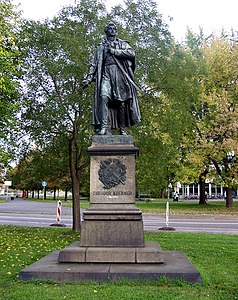Ernst Julius Hähnel
- Machine translation, like DeepL or Google Translate, is a useful starting point for translations, but translators must revise errors as necessary and confirm that the translation is accurate, rather than simply copy-pasting machine-translated text into the English Wikipedia.
- Do not translate text that appears unreliable or low-quality. If possible, verify the text with references provided in the foreign-language article.
- You must provide copyright attribution in the edit summary accompanying your translation by providing an interlanguage link to the source of your translation. A model attribution edit summary is
Content in this edit is translated from the existing German Wikipedia article at [[:de:Ernst Hähnel]]; see its history for attribution. - You may also add the template
{{Translated|de|Ernst Hähnel}}to the talk page. - For more guidance, see Wikipedia:Translation.



Ernst Julius Hähnel (9 March 1811 – 22 May 1891) was a German sculptor and Professor at the Dresden Academy of Fine Arts.
He is especially remembered for his public statuary. His works of art can be admired throughout Germany.
Life
He was born in Dresden on 9 March 1811.
He originally studied architecture at the Dresden Academy then, in 1826, went to the Academy of Fine Arts, Munich, where he remained until 1831 and later switched to sculpture after taking classes with Ernst Rietschel and Ludwig Schwanthaler. He took a study trip to Rome and Florence and returned to Munich, living there from 1835 to 1838, when he was appointed to the Dresden Academy.
Upon arriving there, Gottfried Semper entrusted him with the preparation of some sculptures for the new Semperoper (Opera House). In 1845, he created the Beethoven Monument in Bonn, the work which made him famous. He became a full Professor at the Dresden Academy in 1848.[1] Johannes Schilling and Christian Behrens were among his best-known students.
In 1859, he received an Honorary Doctorate from the University of Leipzig and, in 1883, became an Honorary citizen of Dresden.
He died on 22 May 1891 and is buried in the Old Catholic Cemetery in south Dresden.[2] The original grave was removed due to the German practice of requiring ongoing payments by relatives not being paid, but was replaced by a new grave in April 2016.
Selected works
- 1867: Statue of King Frederick Augustus II of Saxony in Dresden
- 1874: Equestrian statue of Count Frederick William, Duke of Brunswick-Wolfenbüttel in Braunschweig
- 1874: Plaque of Ludwig Tieck at the former location of his home near the Altmarkt in Dresden[3]
-
 Beethoven Monument, Bonn (1845)
Beethoven Monument, Bonn (1845) -
 Emperor Charles IV in Prague (1848)
Emperor Charles IV in Prague (1848) - Equestrian statue of Karl Philipp Fürst zu Schwarzenberg in Vienna (1867)
-
 Theodor Körner Monument in Dresden (1871)
Theodor Körner Monument in Dresden (1871) -
 Leibniz Monument in Leipzig (1883)
Leibniz Monument in Leipzig (1883)
Other notable works
- Raphael, Albertinum, Dresden
References
- ^ Hähnel, Ernst Julius. In Volker Klimpel: Berühmte Dresdner. Hellerau-Verlag, Dresden 2002, ISBN 3-910184-85-5, p. 61.
- ^ Gertraude Stahl-Heimann: Dresdner Friedhöfe und ihre Besonderheiten. Rhein-Neckar-Zeitung, Heidelberg 1996, S. 53.
- ^ Kunst im öffentlichen Raum. Informationsbroschüre der Landeshauptstadt Dresden, Dezember 1996.
Further reading
- Berndorfer Metallwarenfabrik: Die Monumental-Arbeiten der k.k. Kunst-Erzgiesserei in Wien, Vienna (1901), pg. 21.
- Hähnel, Ernst. In: Ulrich Thieme, Felix Becker et al.: Allgemeines Lexikon der Bildenden Künstler von der Antike bis zur Gegenwart. Vol. 15, E. A. Seemann, Leipzig (1922), pgs.427–428.
- Ilse Krumpöck: Die Bildwerke im Heeresgeschichtlichen Museum, Vienna (2004), pg.65.
External links
 Media related to Ernst Hähnel at Wikimedia Commons
Media related to Ernst Hähnel at Wikimedia Commons
















